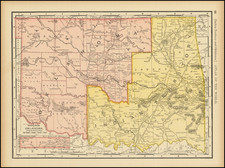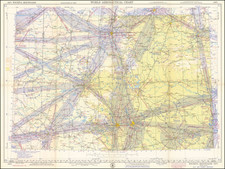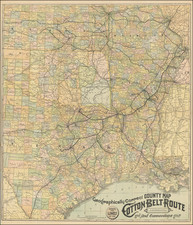Promoting Home Sales in McAlester and Krebs, Oklahoma
This 1912 promotional broadsheet for real estate in McAlester and Krebs, Oklahoma, serves as a compelling artifact of early 20th-century American urban development. Published by the McAlester Real Estate Exchange and signed by R.E. Seamans, President, the broadsheet is designed to attract potential investors and settlers by highlighting the rapid growth, promising future, and profitable real estate opportunities in these burgeoning towns.
The broadsheet includes a detailed map of McAlester and Krebs at the top of one side of the sheet. This map illustrates the layout of plots, major landmarks, and infrastructure, providing potential buyers with a clear understanding of the towns' planned development. The map is accompanied by a certification from July 28, 1911, affirming its accuracy and reliability. Population statistics for McAlester, Krebs, Alderson, Bache, Dow, and Hartshorne are also provided, emphasizing the growing communities in the area.
Below the map are numerous testimonials from satisfied investors and settlers, lending credibility and personal endorsement to the promotional material. These testimonials highlight various aspects of McAlester's appeal, including its potential as a future steel center, the pleasant living conditions, and the educational, social, and financial advantages of residing there. Notably, testimonials from investors such as John S. Fetterly and C.J. Stewart provide personal anecdotes that reinforce the overall message of prosperity and growth.
The verso includes an historical sketch of McAlester, drawing an evocative comparison between the town's growth and the symbolic endurance of a lone pine tree that witnessed the transformation from wilderness to urban center between 1897 and 1912. This narrative is intended to convey a sense of stability and progress, suggesting that McAlester's development is both inevitable and beneficial. The text underscores the significant increase in land value, indicating that a modest investment in 1897 would have appreciated substantially by 1912, thus making a strong case for the profitability of real estate investments in the region.
The verso is also rich in visual content, featuring photographs of key buildings and residential properties in McAlester. These images depict a range of architectural styles and public amenities, from the Busby Hotel and U.S. Post Office to various schools and churches, illustrating the town's infrastructural development and community spirit. The images serve to visually corroborate the textual claims of progress and modernity, making the case for McAlester as a desirable place to live and invest.
The promotional language calls on potential investors to recognize the burgeoning opportunities in McAlester and Krebs, urging them to act swiftly to capitalize on the rising demand and property values. The text appeals to a sense of foresight and prudence, suggesting that investing in these towns is not merely a financial decision but a contribution to the growth and prosperity of an emerging urban center.
McAlester and Krebs, Oklahoma
McAlester, the county seat of Pittsburg County, Oklahoma, derives its name from James Jackson McAlester, an early settler and businessman who later became lieutenant governor of Oklahoma. Known as "J.J.", McAlester married Rebecca Burney, a member of a full-blood Chickasaw family, which granted him citizenship in the Chickasaw Nation. McAlester is notably home to the Oklahoma State Penitentiary and the McAlester Army Ammunition Plant, making it a significant location for both civilian and military activities.
The origins of McAlester can be traced back to the intersection of the east-west California Road and the north-south Texas Road. Initially part of Tobucksy County in the Moshulatubbee District of the Choctaw Nation, the settlement was founded by Alyssia Young in 1838 and named Perryville after James Perry, a Choctaw who established a trading post there. During the Civil War, Perryville served as a Confederate supply depot. However, it was destroyed by Union forces in 1863, and the town never fully recovered its pre-war prominence.
In the post-war period, J.J. McAlester, leveraging his knowledge of local coal deposits, established a trading post and general store in Bucklucksy (later McAlester) in 1869. His strategic acquisition of coal rights and foresight in the impending arrival of railroads led to the town’s growth. The Missouri-Kansas-Texas Railroad, known as the Katy Railroad, reached McAlester in 1872, prompting the relocation of businesses from Perryville to McAlester and cementing the latter’s status as a commercial hub. McAlester's marriage to Rebecca Burney further facilitated his business ventures by allowing him to acquire land and mineral rights within the Choctaw and Chickasaw nations.
The establishment of the Choctaw Coal and Railway by Edwin D. Chadick in 1888, although initially contentious, significantly contributed to the region’s development. South McAlester, formed around this railway, grew rapidly and eventually merged with North McAlester in 1907 to form a single municipality under the name McAlester. This unification, formalized just before Oklahoma's statehood, marked a pivotal moment in the town’s history.
McAlester's coal industry attracted a diverse workforce, including miners from Pennsylvania and Italy, who settled in the area in the late 19th century. The influx of these workers and their families contributed to the town’s cultural and demographic diversity. By 1900, South McAlester had a significantly larger population than North McAlester, highlighting the impact of the railroad on urban growth.
Krebs, established in 1886 and incorporated in 1903, began as a coal-mining camp. Named after Judge Edmond Folsom Krebs, a figure of mixed German and Choctaw ancestry, Krebs attracted European immigrants, particularly Italians, who worked in the local mines. Despite a devastating mining explosion in 1892 that killed around 100 workers, the mining industry in Krebs continued to thrive. The town's connection to McAlester via the Choctaw Railway and Lighting Company interurban railroad facilitated its development.
By 1907, the same year Oklahoma gained statehood, Krebs had developed its own municipal government and school system. The construction of significant buildings, such as St. Joseph's Catholic Church and the town’s opera house, marked its growth as a community. The establishment of multiple newspapers in Krebs further reflects its dynamic social landscape during this period.











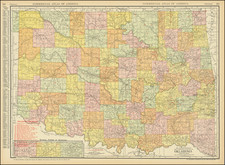
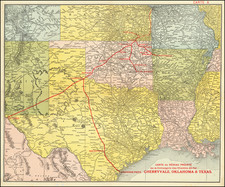
![[Kansas City - Witchita - Tulsa - Enid - Springfield] Kansas River (360) World Aeronautical Chart](https://storage.googleapis.com/raremaps/img/small/96224.jpg)
